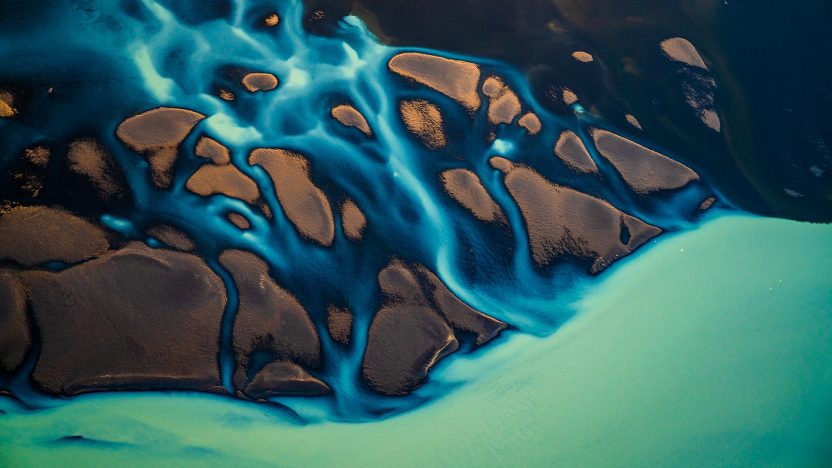
Free to migrate
Migration has had and still has a great impact on human history: it shapes countries, economies, cultures and — now more than ever — the climate.
by Christian Elia
Simulating the motion of waves to ascertain the direction of the wind in footage taken from the sea. By cross-referencing this with historical weather data, we can confirm the direction in which the vessel was travelling and confirm that the vessel was towed towards Italy instead of back to Libya. (Forensic Oceanography and Forensic Architecture, 2018).
“The most reliable data we have show that anthropogenic climate warming is restarting the great engine of migration. Between now and mid-century, it will trigger a massive flow of 230 to 250 million people, forced to flee from where they live. Desertification will drive populations to migrate. A momentum that walls and borders will not be able to stop.”
Telmo Pievani is a Full Professor at the Department of Biology, University of Padua. He is sure: humanity is facing a historic turning point. The interaction of climate change and migration is inevitable, and reversing the relationship between humankind and natural resources is the only way we will manage to cope with climate change. Pievani, however, is by no means one who approaches all this with a doomsday attitude but instead — within the scope of his research — sets it among normal human phenomena.
“I have an evolutionary perspective on migration: moving, relocating throughout our space, and seeking resources, are primary human behaviors. It’s always occurred, and it’s always been somewhat destabilizing, but ultimately the evolutionary outcome is that migrating has been a major boon for us. We are who we are because of migration,” Telmo explains. “Humans have always lived in an unstable, constantly changing natural environment. The difference is that in the past, climate changed due to natural cycles, whereas nowadays, it changes because of human impact. Migration has always been a strategy of flexibility and adaptability that has brought about human diversity. That’s why describing migration as an emergency, and being surprised by these flows, is at the very least bizzare,” says Pievani. “The constraints of migration have changed: they used to be physical, natural, and climatic. Vegetation zones and mountain ranges, river and coastal corridors. These physical boundaries are still there, but we have added a cultural web of political boundaries that make migration more volatile, more dramatic and full of conflicts.”
Taking a scientific, ideology-free approach, Pievani examines migration by putting it in context and looking at the data. “Out of 100 people who move, only 20 are fleeing from wars, persecution, and discrimination. The other 80 are migrating because of the effects of climate change. This makes us wonder about the categories involved: who are the refugees? Who has the right to seek asylum? Those fleeing from war certainly have it, but it should also be granted to those who no longer have water to drink: they are environmental refugees.”
From an evolutionary perspective, several factors are in play. Although immense, they are never absolutely unprecedented. Studying these phenomena, and describing them with a different approach, has become essential, a change we can no longer afford to postpone. For example, by focusing the public debate about migration on the positive effects it has on society. Pievani is convinced of this. “The benefits of migration are obvious, as all demographers say. The powers of the future will be those who are now capable of attracting the best young people in terms of creativity and desire to start a family, who will pay for our pensions with their work thirty years from now. While countries that do not have young people, because they are fleeing or because their population is shrinking, like Italy, have no future. I am not mentioning Italy by chance: once again, last year, tens of thousands of well-trained and talented young people left their country to go abroad. In general, the world is experiencing a period of population growth, which will continue for certain at least until the middle of the century, when there will be nine or ten billion people on Earth.

By mapping the sky to the inside of a sphere, we track the motion of a mounted camera and match the drifting movements of the vessels in the scene. (Forensic Oceanography and Forensic Architecture, 2018).
It’s an unbalanced picture, with areas such as Europe facing a decline in birth rates while areas such as Sub-Saharan Africa are exploding, in terms of population. Many young people there are eager to build a future for themselves, working and building a family, and that is not only fair and natural, but it is advantageous for us, and always has been. Different demographic forces greatly impact migration, and this is nothing new, as a human phenomenon. Just consider the period from the end of World War II to today: migration has not only occurred in the past but always has, and does in our time. Tens of millions of people have migrated since 1945. People who have made the economic fortunes of the countries they went to, such as the United States, Brazil, and Argentina.
What we must do is to handle this phenomenon in a wise and forward-looking way, without being afraid of it, because that would make no sense. It would be like thinking of emptying the ocean with a teaspoon. Therefore, on the one hand, there is the economic advantage, which is also the most obvious, and on the other hand there is the mixing and cultural enrichment, which is genetic and biological, something I find much more interesting. Mixed families are a blessing from an evolutionary point of view because they blend the genetic heritage, they generate diversity, and this is what societies require to revitalize themselves. Just think of the Albanian community in Italy: 30 years after the Vlora ship docked in Bari with its tens of thousands of refugees, the value of the energy brought to the country by the current generation born and raised in Italy is enormous”, explains Professor Pievani.

Projecting photographs onto a 3D model in order to determine the distance between the observed vessels and infer the position of the photographer. (Forensic Oceanography and Forensic Architecture, 2018).
Ultimately, a turning point causes itself, with processes that cannot be stopped, but must be dealt with. With a proper and correct narrative, with a willingness to challenge oneself, even with respect to victimization. After all, from the Balkan Route to the Mediterranean, an entire generation lives on the border, being born and growing up there. And in the long run, this can become a great resource.
“It is normal and fair that the traumas and sense of insecurity of those who live and are born on the border be studied,” Pievani replies, “they are uprooted lives, perpetually on the move, in challenging conditions. This should not be underestimated, but there is also a positive aspect: the future is theirs. Dramatically, but inevitably, they have internalized a dynamic and evolutionary concept of borders. For them, the border is a great opportunity. For them, crossing a border also means stepping into a world of opportunity, as it was for Italians in the United States or elsewhere. Fundamentally, from an anthropological point of view, they have a huge advantage. Because they have that dynamic perception of life that we — for the most part — have lost. Especially those who persist in the idea of borders that close rather than open. Borders have their own charm, just think of split cities such as Berlin and Nicosia. I’ve studied them, I am strongly attracted by them, even if I can’t explain it. A line that separates two worlds, two realities, that joins and divides at the same time, is fascinating. And creative, as shown by the Berlin that came after the wall came down. A dynamic vision of borders is a tremendous thrust, which many of us have lost.”

At the moment where NGO vessel Iuventa first photographed two migrant boats in distress, we capture the relative positions of the vessels by mapping the surface of the image onto the surface of the sea. (Forensic Oceanography and Forensic Architecture, 2018).
Change, however, needs to build up an imaginary to materialize. Sometimes it has to be built from scratch, sometimes it has to be regenerated. As in the case of the empathy that welcomed people after the fall of the Berlin Wall, the common sense that recognized that others have the right to be happy. “We need to take a further leap: it’s not enough to simply recognize the right to migrate and be happy, which fortunately is also increasingly corroborated by documents. The change of pace, as for all rights, would be to include as many people as possible”, explains Professor Pievani. “It must also be said, however, that in an ideal situation, a right is recognized regardless of need. In international regulations and current conventions, the right to migrate and to be happy is recognized when one is suffering or in a condition of hardship. In this case, rightly, the right to migrate is recognized. This, as important as it is, is a defensive measure. Ideally, however, a person should be free to migrate, not just have the right to do so. For the most part, nowadays, migration is a necessity. So those people have not chosen to move. The right is to be happy: where you were born or elsewhere.”
Among the many books Prof.Pievani has written, one in particular, co-authored with geographer Mauro Varotto, is about the future: Viaggio nell’Italia dell’Antropocene. La geografia visionaria del nostro futuro (Journey in the Italy of the Anthropocene. The visionary geography of our future, Aboca Edizioni). The two authors imagined what kind of Italy Goethe would have found if he had relived his journey one thousand years later. And the result is a country facing a turning point, even if it seems unaware of it.
“First, we must have a common vocabulary to imagine a future. And we are running out of time. Our book’s scientific and cartographic part shows how the maps that envision the Italy of 2786 are beginning to unfold now. An Italy underwater, with the sea 65 meters higher, is not a far-fetched dystopia. Desertification is already happening in Puglia, Sicily, and Calabria, which will have the climate of present-day Libya and North Africa. Within climate change, there is also the topic of borders. Italy — no one ever seems to mention this — is the country with the greatest biodiversity in Europe: a real biodiversity hotspot. It’s a gateway, from east to west, from south to north. Italy has always been a place you must inevitably cross, which applies to plants, animals, and human beings. Other countries are also passageways, but Italy has such biodiversity also because of its varied and irregular terrain, with two perpendicular mountain ranges and a very broad range of climates. Italy owes all this to being a cross-roads. Protecting this immense biodiversity heritage is what, in the future, will enable the country to recover, perhaps by repopulating the Apennines, and relocating its coastal communities, because Italy is one of the countries most exposed to climate change. We are not doing enough to turn this into an opportunity. It is a lack of foresight and of forward-thinking of our leadership classes,” explains Pievani.

Projecting photographs onto a 3D model in order to determine the distance between vessels observed and infer the position of the photographer. (Forensic Oceanography and Forensic Architecture, 2018).
Without the rhetoric that marked the early stages of the pandemic, could this really have been a time of change, of a change of course? “The very strong link between climate change, migration, and the environmental crisis made the pandemic tragedy an opportunity to understand what happened. But we’re not doing that. The pandemic is the moment of sudden revelation of our fragility. It reminds us that we are African mammals born the day before yesterday and that we are vulnerable to pathogenic viruses our immune system is not prepared for,” Pievani concludes.
“Pandemics have always been there, and our ancestors survived, but it would be wrong to brush it off, saying it is one of many. Back then, there were not billions of people on Earth, we did not travel on intercontinental planes, and we were not such a perfect host for viruses. In the last thirty or forty years, pandemics have become more frequent, more violent, and that’s no coincidence. The degradation of the environment due to human actions, the destruction of ecosystems, and the unhealthy relationship we have with virus-carrying animals, are all processes generated by our predatory economic model. We are paying for the depredation of the environment, and we are further promoting it through climate change. This is the great challenge we have before us, linked to both migrations and pandemics: to reassess our relationship with the biosphere and stop saying that it is the migrants who carry the viruses. It insults logic. Migration, the way borders work, is a dramatic and vicious selection of the fittest. As a study in The Lancet showed, the virus has traveled with managers, tourists, and goods. Restarting based on reality is the only way to build the future.”



 in Italy
in Italy